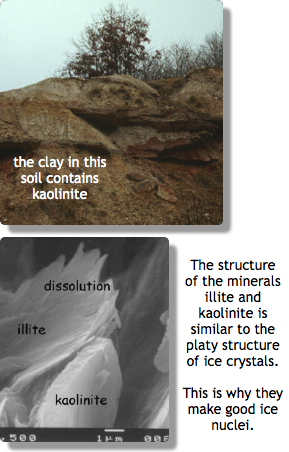
|

|


What happens inside a cloud?
Micro-scale Processes - Ice Crystal Formation
 Although the ice embryo discussed on the previous page acts as a
nucleus for ice formation,
other ice nuclei are very important for ice crystal formation.
Particles serve as excellent ice nuclei if their geometry resembles that of an
ice crystal. For example,
clay minerals are effective nuclei
at temperatures near -15 C (5 F). Some types of bacteria and ice crystals
themselves are also good ice nuclei.
Ice can form on a nucleus through three processes: deposition, contact, or
freezing. In deposition, water vapor deposits directly as ice onto the nucleus.
Contact freezing occurs when
supercooled droplets
collide with ice nuclei. Finally, freezing nuclei promote the freezing of
supercooled liquid droplets.
Although the ice embryo discussed on the previous page acts as a
nucleus for ice formation,
other ice nuclei are very important for ice crystal formation.
Particles serve as excellent ice nuclei if their geometry resembles that of an
ice crystal. For example,
clay minerals are effective nuclei
at temperatures near -15 C (5 F). Some types of bacteria and ice crystals
themselves are also good ice nuclei.
Ice can form on a nucleus through three processes: deposition, contact, or
freezing. In deposition, water vapor deposits directly as ice onto the nucleus.
Contact freezing occurs when
supercooled droplets
collide with ice nuclei. Finally, freezing nuclei promote the freezing of
supercooled liquid droplets.

Micro-scale Processes - Ice Crystal Formation
 Although the ice embryo discussed on the previous page acts as a
nucleus for ice formation,
other ice nuclei are very important for ice crystal formation.
Particles serve as excellent ice nuclei if their geometry resembles that of an
ice crystal. For example,
clay minerals are effective nuclei
at temperatures near -15 C (5 F). Some types of bacteria and ice crystals
themselves are also good ice nuclei.
Ice can form on a nucleus through three processes: deposition, contact, or
freezing. In deposition, water vapor deposits directly as ice onto the nucleus.
Contact freezing occurs when
supercooled droplets
collide with ice nuclei. Finally, freezing nuclei promote the freezing of
supercooled liquid droplets.
Although the ice embryo discussed on the previous page acts as a
nucleus for ice formation,
other ice nuclei are very important for ice crystal formation.
Particles serve as excellent ice nuclei if their geometry resembles that of an
ice crystal. For example,
clay minerals are effective nuclei
at temperatures near -15 C (5 F). Some types of bacteria and ice crystals
themselves are also good ice nuclei.
Ice can form on a nucleus through three processes: deposition, contact, or
freezing. In deposition, water vapor deposits directly as ice onto the nucleus.
Contact freezing occurs when
supercooled droplets
collide with ice nuclei. Finally, freezing nuclei promote the freezing of
supercooled liquid droplets.

